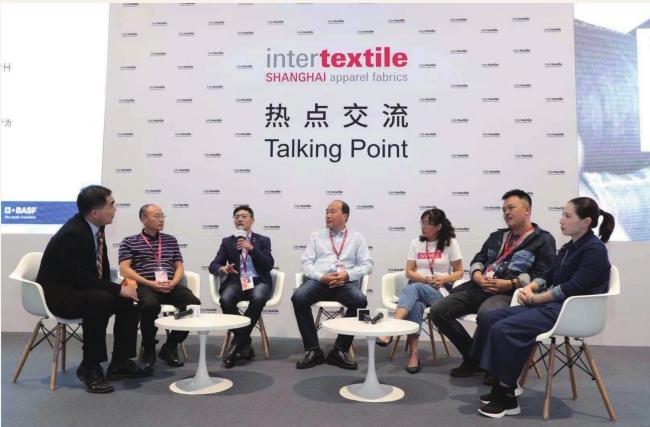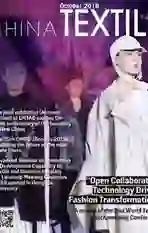“Chemistry is the New Black”:BASF innovative solutions enable new possibilities for fashion industry
2019-12-02
At Intertextile Shanghai Apparel Fabrics, under the theme of “Chemistry is the New Black”, BASF showcased a variety of sustainable solutions, from raw materials for chemical fibers to denim wash auxiliaries and accessories made by 3D printing. These solutions help the textile industry make the production more stable and efficient while reducing carbon emissions. In addition, BASF has launched a new brand, “PolyTHFTM Inside”, at its Denim Industry Development Trend Forum concurrently held with the exhibition. The spandex products endorsed with the brand will provide fabric manufacturers with guaranteed product performance and stable production process.
“We are proud to introduce the ‘PolyTHFTM Insidebrand to our customers. This new brand represents high product quality and BASFs commitment to supporting our customers through innovation and customized solutions,” said Dr. Bei Hu, Vice President of Business Management for Intermediates Greater China, BASF. “We are delighted that Hangzhou Banglian Spandex (Banglian), one of the spandex yarn producers with advanced fabrication technologies, will use ‘PolyTHFTM Insidebrand for its spandex yarns for denim fabrics. Together with Banglian, we will contribute to the healthy and sustainable development of the Chinese textile industry.”
Leveraging on the knowledge and expertise on PolyTHF (polytetrahydrofuran), the key material to produce spandex, BASF has become one of the leading producers of PolyTHF over the past three decades. Textiles that contain “PolyTHFTM Inside” are soft and durable, which provide a sense of comfort to users. Due to its superelastic feature, spandex has become one of the most popular textile materials and is often found in a variety of apparels, including sportswear, intimate apparel, outerwear, and swimsuits.
“Chinas chemical fiber industry has been upgrading and transforming rapidly. However, the spandex products in China are still catching up in terms of variety and the ability to innovate to meet customers needs,” said Mr. Duan Xiaoping, President of China Chemical Fiber Association. “Spandex, especially used in denim fabrics, often loses its elasticity after being treated in multiple treatment processes. Therefore, innovation in raw materials and production technologies plays a crucial role in the development of the spandex industry.”
Other innovative solutions to be presented at Intertextile Shanghai Apparel Fabrics include:
◎Bio-based BDO (1,4-butanediol), the raw material of PolyTHF based on renewable feedstock, contributes to sustainable growth without compromising performance.
◎Lutensol? AT 80, an anti-back-staining auxiliary which protects the white ground and is best compatible with denim enzymes that create the vintage look and soft feel.
◎Non-ionic surfactants, chelates, optical brightening agents and polymers for pretreatment, dyeing, printing and finishing processes, such as phosphate-free dispersing agents, high-performance dyes, transfer inhibitors, stain remover, fiber lubricants, emulsifier, wetting and leveling agents.
◎A portfolio of start-up companies supported by BASF Venture Capital for photonic metamaterial for dynamic coloring technology and a wide range of additive manufacturing solutions as well as other textile related solutions.
BASF in Greater China
BASF has been a committed partner to Greater China since 1885. With larger production sites in Shanghai, Nanjing and Chongqing, BASF is a major foreign investor in the countrys chemical industry, and operates the Innovation Campus Shanghai, a global and regional research and development hub.
BASF posted sales of more than 7.3 billion in 2018 to customers in Greater China and employed 9,317 people as of the end of the year. Greater China is currently BASFs third largest market after Germany and the United States.
BASF currently operates 25 major wholly-owned subsidiaries, nine major joint ventures, and maintains 24 sales offices in Greater China. BASFs business in Greater China includes petrochemicals, intermediates, performance materials, monomers, dispersions & pigments, performance chemicals, catalysts, coatings, care chemicals, nutrition and health, agricultural solutions and construction chemicals.
These chemicals are used in almost all areas of daily life such as in houses, cars, food, agriculture, pharmaceuticals, textile, household goods, electronic equipment and packaging. BASF has invested more than 6 billion in Greater China (more than 9 billion with partners) to build a locally competitive production, marketing, sales, technical service and innovation network.
Research & development
◎R&D teams in Greater China serve almost all major industries in Asia Pacific
◎Key milestones of the Innovation Campus Shanghai
◎Inaugurated in 2012, located at the Shanghai Pudong Innovation Park, focusing primarily on advanced materials and systems, chemical process engineering, and environmental catalysts (labs located at the BASF Jinqiao site in Shanghai, which is an integral part of the Innovation Campus Shanghai)
◎Second phase completed in 2015 to include a new R&D building
◎Advanced Materials & Systems Research, one of BASFs three global research platforms, headquartered in Shanghai since January 2016
◎The first regional Design Center for Asia Pacific, opened in May 2016
◎BASF Automotive Application Center and BASF Process Catalysis Research & Development Center operational from March 2019
◎Total investment: around 180 million
杂志排行
China Textile的其它文章
- Dear readers
- Open Collaboration,Technology Driven,Fashion Transformation
- Global industrial collaboration is imperative
- Witnessing the future of global textile industry,the“World Textile Merchandising Declaration”officially released
- Fashion Transformation!“China Textile City Cup”2019 Global Fashion Design Elite Challenge is the perfect ending
- 2019 Keqiao Fashion Week(Autumn) sparkled in Keqiao
